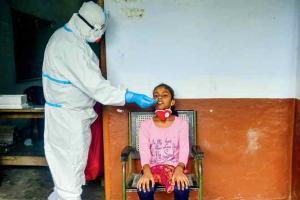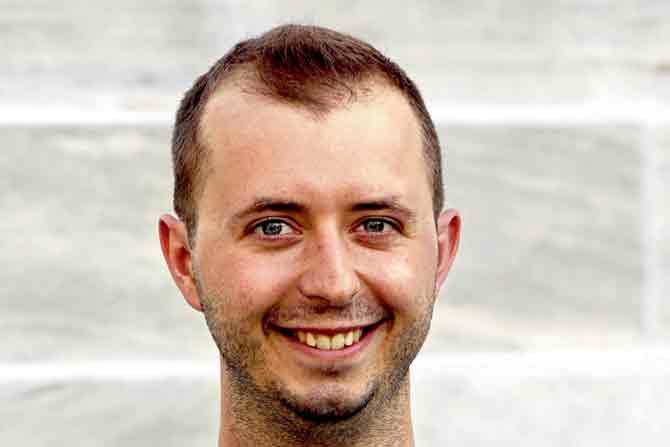While we may have lost precious time for research by assuming that children arent at as much risk of contracting COVID-19, recent findings say they could become spreaders, and schools, hotspots

Researchers say that one of the biggest challenges is that children are less likely than adults to have symptoms, meaning many infections may go undetected. PIC/AFP
While children are usually seen as vulnerable, a few weeks into the Coronavirus pandemic, several global researchers observed that children's risk of needing hospital treatment for COVID-19 infection was "tiny". Among these, a study in the BMJ—a weekly peer-reviewed medical journal in Britain—gained most attention. It looked at 651 children with Coronavirus in hospitals in England, Wales and Scotland. A "strikingly low" one per cent of them—six in total—had died in hospital with COVID-19. Compare this with 27 per cent across all other age groups. Eighteen per cent of the children needed intensive care. And the six who had died had "profound" underlying health conditions that had often been complex and themselves life-limiting. Some more papers came to the fore, claiming kids were less likely to catch and transmit the virus.
ADVERTISEMENT
In the first week of September, however, the World Health Organization (WHO) made an announcement that seemed at odds with what was being assumed thus far. It recommended that children aged 12 and beyond should wear masks, and that masks should also be considered for those aged between six and 11. "The assumption that kids will not transmit the virus came from Sweden. Throughout their lockdown, they kept the schools open, while anything else that involved congregation of individuals was not allowed. This led to a feeling that kids don't transmit the virus," believes Dr Lancelot Pinto, consultant respirologist, PD Hinduja Hospital, Mumbai.
_2.jpg)
Dr Lancelot Pinto
Now, a new study titled, Epidemiology and transmission dynamics of COVID-19 in two Indian states, published on September 30 and led by Ramanan Laxminarayan, founder and director of the Centre for Disease Dynamics, Economics and Policy, confirms that children also transmit the virus, mostly among their own group. "This will have implications for whether we want to reopen schools", Laxminarayan said in a TEDx Gateway webinar on August 29, where he presented preliminary findings from the study.
In the largest study ever of transmission patterns for COVID-19, the team tested more than a half-million contacts of 85,000 cases to examine how and to whom the Coronavirus is spreading in two southern states of Andhra Pradesh and Tamil Nadu. "Children accounted for a small proportion, overall, of the 'index' cases whose contacts were traced: 762 were aged 0-4 years, and 5,301 were aged 5-17.
The greatest share of cases whose contacts were traced came from young adults aged 18-29 years (20,655) and adults aged 30-39 years (19,919)," shares Joseph Lewnard, Assistant Professor of Epidemiology at the School of Public Health at the UC Berkeley and co-author of the study.
But why has the role of children in transmission been difficult to assess? Lewnard explains, "One challenge is that children are less likely than adults to have symptoms, meaning many infections may go undetected. Second, the fact that schools have been closed in India and many other places around the world means that we are not observing 'normal' interaction patterns among children: most likely, children are having fewer contacts with others, and the contacts they do have are likely to be with individuals to whom they are very close [siblings and family]. In the context of these interactions, we do see instances in this study where secondary infections are identified among people who came into contact with infected children."

Joseph Lewnard
In Australia, for instance, testing criteria was initially very restrictive. People had to have a fever or cough to be tested, which children don't always have. This hindered their ability to detect cases in children, and created the perception that children weren't commonly infected. But almost seven months into the lockdown, have all our efforts in tracing contacts and tracking the spread gone to waste by ignoring this age group entirely? Laxminarayan doesn't think so. "Children have been mostly at home and the limited transmission has been inspite of this. It is likely that transmission would have been greater had they been at school," he says.
Lewnard says, "Some countries have even issued guidance against testing children. Unfortunately, this has led to missed opportunities to understand patterns of spread.
However, early studies in Germany and elsewhere revealed similar viral load among infected children and adults, suggesting they may be equally likely to transmit infection when they come into contact with other individuals." In addition, there are now well-documented instances of transmission involving children across differing environments. "Earlier in the pandemic, an outbreak in Israel reinforced the need to take precautions to prevent transmission in schools, for instance, through mask wearing, distancing, and opening windows to allow air to flow in and out. A well-documented outbreak at a summer camp in Georgia (United States) led to similar concerns. This week, the US Centers for Disease Control and Prevention published an investigation into an interesting situation, where a 13-year-old girl triggered an outbreak with 11 family members acquiring infection while staying at a vacation house. In light of these findings, it is not surprising that children may play a role in transmission, especially when precautions are not followed."
A recent study published by Oxford has said the Coronavirus vaccine clinical trials for children should begin now, given their vulnerability to the virus. The Oxford study said that while the Coronavirus vaccine trials for adults have moved to Phase III, they are yet to start for children. "The direct impact of Coronavirus upon children is greater than that observed for a number of other pathogens for which we now have effective paediatric vaccines," the Oxford study said.
Days after the central government in India issued Unlock 5 guidelines, allowing states to restart educational institutions in a graded manner from October 15, the Maharashtra cabinet on October 7 decided that in light of the COVID-19 situation, it would take a call on reopening schools only around mid-November. But how wise is this move? "We need to think about schools opening carefully to ensure that they don't facilitate widespread infections. Very few countries have done a good job of opening schools in the middle of a high infection rate. It would not be advisable to go back to the ways in which schools operated prior to March," warns Laxminarayan.

Ramanan Laxminarayan
Lewnard thinks, "Although COVID-19 is an important threat, long-term school closures are damaging to education and well-being. Every effort should be made to learn from the experience of schools that reopened, to learn what practices were safe and what practices led to outbreaks. Enhancing the testing of children to monitor transmission inside and outside of schools is an important part of this, and should be undertaken wherever possible."
Pinto doesn't know if reopening of schools will entirely work in the favour of students. "They will be asked to wear masks, and there is research on how it can cause over exposure to carbon dioxide. So parents would obviously not want their kids to cover their faces [at all times]. I don't think it is surprising that kids will then act as transmitters," concludes Pinto.
Keep scrolling to read more news
Catch up on all the latest Mumbai news, crime news, current affairs, and a complete guide from food to things to do and events across Mumbai. Also download the new mid-day Android and iOS apps to get latest updates.
Mid-Day is now on Telegram. Click here to join our channel (@middayinfomedialtd) and stay updated with the latest news
 Subscribe today by clicking the link and stay updated with the latest news!" Click here!
Subscribe today by clicking the link and stay updated with the latest news!" Click here!






